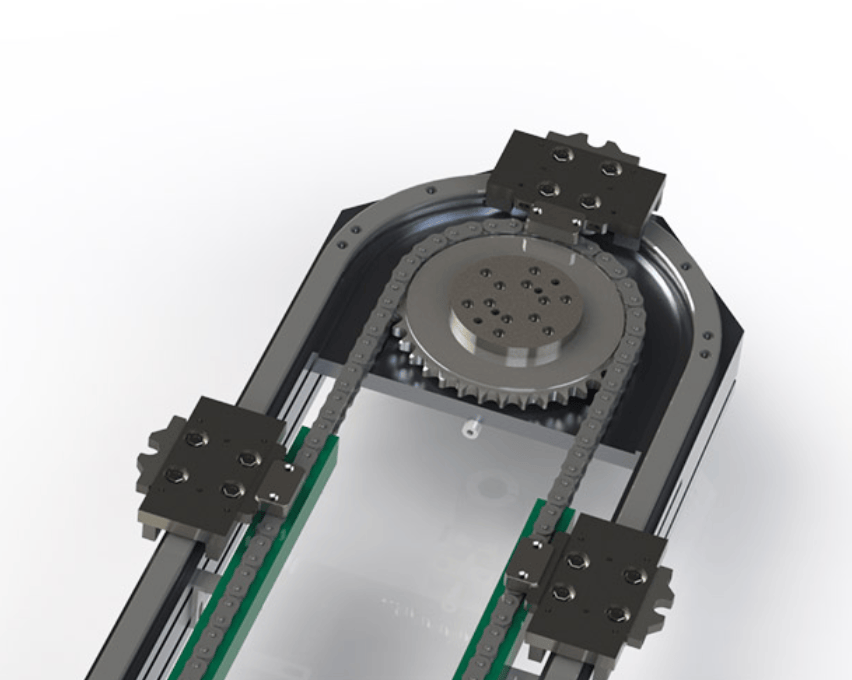## I. Panorama of Technical Parameters: Physical Boundaries of Velocity
The speed of a climbing suspension conveyor line is not an isolated parameter, but isResults of dynamic equilibrium of slope, load and friction coefficient.. Core data reveals its operation:
- Base speed range: Regular running speed 12~60m/min, need to reduce to 12m/min when the extreme slope ≤60°.
- Energy-sensitive zones: Power consumption per 100 metres of monorail grows exponentially with speed, with a steep increase in energy consumption when exceeding 40 metres per minute 52%
- safety threshold: 150kg heavy load scenario, speeds >30m/min will result in the risk of exceeding the amplitude limit.
Industry Insights: 2025 Headline business adoptionSpeed-slope linkage algorithm(e.g. Weitron SDS system), automatically reduces the speed by 20% when the gradient is >30°, which ensures safety and avoids wastage of energy - this dynamic balance extends the life of the equipment by 3 times.
## II. Speed regulation methodology: evolution from mechanical to intelligent
Three methods of traditional mechanical regulation
plaintextmake a copy ofGear speed change: replace the transmission gear set → speed accuracy ±5% Belt tensioning: adjust the roller pitch → adjustable range 10%-15% Inclination compensation: every 10° increase in slope reduces the speed benchmark 8%New Paradigm of Intelligent Control
Three-tier speed management matrixis becoming an industry standard:
- Inverter Driver Layer: ABB vector inverter for stepless speed regulation from 5-60 m/min.
- load-sensing layer: real-time weight monitoring by piezoelectric sensors → automatic matching of speed profiles
- AI optimisation layer: Self-learning algorithm predicts the risk of clogging and reduces speed 12 seconds in advance
## III. Industry Scene Adaptation: the Value Reconstruction of Speed
Automotive Manufacturing
BYD's Xi'an base practice overturns the traditional perception:
| working procedure | conventional speed | Optimisation programme | Effectiveness Enhancement |
|---|---|---|---|
| Body Painting | 20 metres/minute | Constant speed 28 metres per minute | Capacity +40% |
| Battery Packaging | 15 metres/minute | Dynamic speed reduction to 12 m/min on ramps | Loss ↓63% |
| Assembly Conveyor | 30 metres/minute | time-shift strategy | Electricity ↓28% |
New Retail Logistics Revolution
Proof of the hanging sorting system at Yonghui Supermarket:
- economic velocity zone: Peak sorting performance at 22 metres/minute (5,000 items/hour)
- Pulse acceleration technology: Intermittent speed up to 35m/min during peak order period, instantaneous throughput ↑70%
- Slope Loss Reduction Programme: Carbon fibre guide wheels for 45° climbs, maintaining 18 m/min without slowing down.
## IV. Maintenance and energy consumption: the hidden cost of speed
Maintenance intervals quick reference table
plaintextmake a copy of≤ 20 metres/minute: 2000 hours lubrication overhaul 30 metres/minute: 800 hours mandatory maintenance >40 metres/minute: 300 hours bearing inspectionThe Golden Rule of Energy Consumption Control
- Speed partition management: Combination of straight-line speed-up + corner speed-down, with a combined energy efficiency increase of 35%
- Permanent Magnet Motor Replacement: 55 m/min Lower energy consumption than asynchronous motors in the high-speed section 32%
- Regenerative braking technology: downhill section of kinetic energy conversion recovery, feeding the grid efficiency of 18%
## V. Future battlegrounds: the three pivots of the speed revolution
Maglev Technology Breakthrough
- contactless drive: Mass production of maglev guide wheels by 2026, 60 m/min with zero friction loss
- Double the speed: Experimental line measured at 120 metres per minute, twice the conventional limit
- Energy consumption paradox cracked: High-speed section consumes less energy than conventional 40 m/min 15%
digital twin preview
Realised by WeiChuang virtual debugging system:
- Million speed simulations in 48 hours
- VR Remote Adjustment Parameters, Trial and Error Costs Down 80%
- Automatic generation of speed reduction strategies in seismic wave simulations
Three questions and answers about speed control
Q1: How to balance speed and equipment life?
Dynamic load managementIt's the core law:
- Heavy load (>100kg) Scene locking ≤30m/minute
- Installation of laser vibrometer for real-time amplitude monitoring
- Increase lubrication frequency by 231 TP3T for every 101 TP3T of speed increase.
Q2: Which parameters most affect the upper speed limit?
Four-dimensional matrix of key indicators::
- Rail material: self-lubricating resin>carbon steel (low coefficient of friction 58%)
- Chain Pitch: 250mm pitch has more room for speed increase than 150mm 40%
- Slope angle: 1/3 decrease in speed limit for every 15° increase
- Ambient temperature: >40 ℃ need to reduce speed 15% to prevent thermal deformation
Q3: How can county enterprises break through technological bottlenecks?
Low-cost upgrade path::
- Conversion of conventional gear sets to inverter motors (cost <30,000 yen)
- Automatic speed control by adding load cells
- Extended high-speed cycle time with UPE abrasion-resistant edging
Exclusive data insights
Global Climbing Suspension Conveyor Line Market size will exceed $38 billion in 2027, of whichHighly efficient system with speed > 40 m/minThe share will be 67%. it is worth noting that theEU Carbon Footprint Monitoring Module(mandatory installation in 2027) has forced Chinese enterprises to upgrade, a company in Shandong installed speed - energy linkage module, although the cost of equipment increased by 18%, but the German order soared 200% - proof of theGreen speed is reshaping global supply chain competitiveness standards.
: Slope Speed Algorithm
:: Pulse acceleration technology
: Magnetic Levitation Guide Wheel
: Inverter Driver Three-Tier Architecture
:: Dynamic load management
Source of technical parameters:
: White Paper on High-Speed Monocoque Suspension Systems (2025)
:: BYD Intelligent Conveyance Case Library (2024)
:: EU CE-LVD energy efficiency standard (2026)
:: Weitron Virtual Commissioning Technical Documentation (2025)













